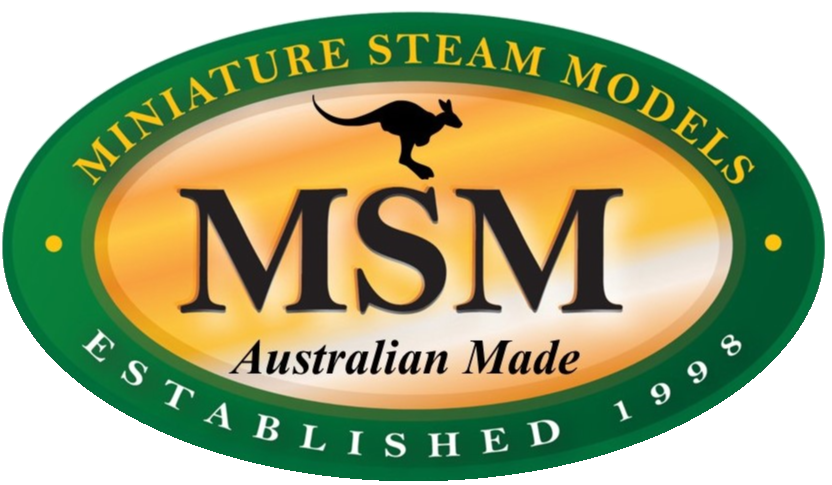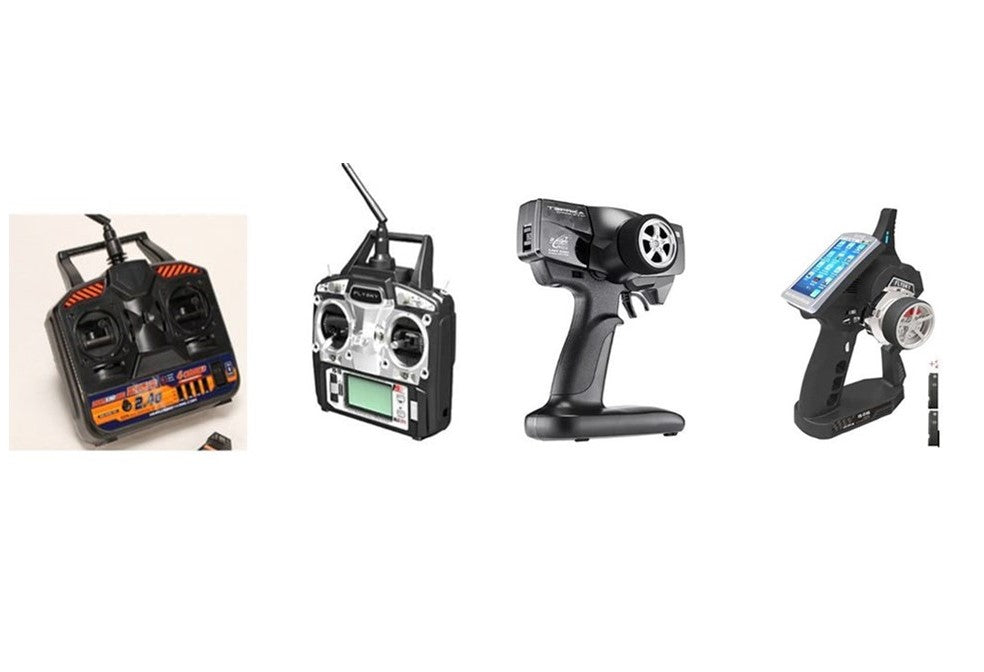Introduction to Radio Control (RC) of Steam Powered Model Boats
Basics of Radio Control of a steam-powered boat:
There are three basic elements of control you need for your steam powered boat, rudder control for steering, steam volume control for speed, and if your boat is capable of reverse, a control to set Forward or Reverse. You may have accessory items such as a steam whistle, or even battery powered lighting on your vessel that may need controlling.
Remote “Radio Control” (RC):
This is achieved by a transmitter unit(Tx) which you hold and manipulate, and a boat-mounted battery-powered receiver(Rx). The “servo motors” that control the functions are connected to separate “channels” in the receiver. Each servo will have a “control arm” that rotates upon command, and this arm is connected by a linkage to the feature of the engine or the boat. The direction of the linkage will depend on the steam engine configuration and the way you have it in the boat. The location of the receiver, servos and battery pack in the boat is a planning factor. Although they are small and light, the on-board components must be carefully positioned: they may affect the correct balance of the boat; they must be oriented in such a way that the servo arms swing in the right direction; and you will want to find a place of concealment in the boat so the appearance of a “classic steam boat” is not compromised by these “modern” infrastructure
So, your model boat is 1000 feet away on the lake, and you remain totally in control of her—perfect!
Radio Systems:
Typically the Tx and the Rx hardware are sold together. They are “paired” together in a binding process so that your Tx will communicate only with your Rx. If necessary, the binding operation can be redone by the owner according to directions supplied. There should be no reason to substitute a different model receiver, and to do so is a moderate risk of non-compatibility.
On a stick radio there is a parameter called “Mode” which describes the functions of the two sticks. Modes 1, 2, 3, and 4 are available; most likely you would use Mode 2 where the steam control (throttle ) is controlled with the up-down of the left stick, and the left-right motion if the right stick control the steering.
Alternately, Mode 1 would have both these controls on the right stick.
On a pistol grip radio, there are no mode variations, but the trigger setting usually has a center point. Squeezing in increases speed in Forward and pushing the trigger forward will cause speed to increase in Reverse. There may be many variations of this configuration for a steam boat—these radios are designed typically for RC cars and boats with DC electric motors, and the trigger is used for braking.
Safety Basics
The radio you select should be new technology radio transmission at 2.4gHz operating frequency. This will avoid the #1 danger of having a nearby RC boat “interfering” with your radio transmission and accidentally telling your boat to do something crazy, like smash into another boat.
If you are using other RC technology, make certain you are clear about its legal use, and the possibilities of interference from other radios.
Never grip the antenna when operating.
Don’t let people or body parts get between the transmitter and the boat. These situations will degrade the radio (RF) transmission and the boat may go out of control.
Salt water will damage the transmitter or the receiver. Avoid exposure to water and extremes of temperature as well.
Your judgment is required if you intend to have children younger than 13 years old operating the boat.
Selecting a System:
There are two basic types of RC transmitters: “Stick” or “Pistol-Grip”. Either is totally appropriate for a boat, and the choice is really the operator’s comfort and preference.
This Guide has a focus on the “Stick” version of the transmitter.
The other parameter for the system choice is the number of “Channels” or functions that you need for your boat. RC Systems can have many channels. Recent developments have a minimum that far exceeds the needs of a simple steam powered engine.
Stick transmitters are just that: the controls are achieved by moving “joysticks”. Boat operations can be controlled with one or both sticks on the radio; there will normally be a minimum of 4 channels controlled by a stick radio.
The more sophisticated radios will have a computer display and more functional capability.
A pistol grip transmitter is also aptly named—you hold the unit one hand like a pistol and squeeze a “trigger” to control the boat speed and maybe its Fwd/Rev function. (More on that later). Rudder control is made by turning a large round wheel mounted to the side of the transmitter body, and the boat can be steered as if with an actual wheel. Pistol grip systems are available with 2-6 channels. Pistol grip radios are most often sold as “for car or boat” whereas such wording is never found on a stick radio.
The radio transmitter unit will have additional switches and knobs for controls of various functions.
The cost variations of available RC gear are staggering, but it is most likely that the most basic stick radio system will be adequate for your needs.
The most basic systems have limited “set up” controls and fewer channels and will not have a computer control display. In general, a system without computer control will make the mechanical adjustments of the control linkages more difficult. The key word here is “End Point Adjustment”, meaning transmitter control during set-up of how far the servo arm moves when the stick is pushed to its extreme.
System Configuration:
By now we have mentioned most of the components in the system—Transmitter (Tx), Receiver (Rx). servos, and battery (more later). Please refer to the specifics of your RC system for the correct configuration of the components. For example, following is a schematic of the configuration you might use on your steam powered boat using a 6-channel stick radio. It is easy to imagine how a system with fewer channels might be configured.
Radio Control
Radio range
This is the allowable distance between Tx and Rx for secure operation—is pretty much line of sight—if you can see the boat, it will be in range. Degradation of signal—leading to a reduction in range or interruption- will occur if there are objects between the Tx and the Rx (nobody stands in front of you!) and severe weather like heavy rain or mist could also be a factor. Also, you will want to mount the receiver in the boat in a way it can never get wet from bilge water. Usually, a space up under the deck can be found to locate the receiver safely. A wet receiver will have zero range.
Servos on the Boat:
These are the tiny motors that are commanded by Tx to rotate in a certain direction, usually up to 45 degrees in each direction from the center (a 90 degree swing). They will respond in a proportional manner to the command from the radio—in other words, moving a stick half-way on the radio will cause the servo to move half its arc.
There will be a way on your radio to “Reverse” the servo action, to give the opposite motion. Selecting the servo for your boat is a personal choice depending on size, functionality, and budget. You will need to consider the torque capability of the servo, its size and weight and type of cable connector to fit into your receiver. (The connectors are almost universal, but this is not always true. As always, care MUST be taken to orient the servo connector properly in the receiver; the black wire (DC ground) is usually at the bottom of the connector panel on the receiver). The servo must be oriented in the boat such that its control arm will swing in the proper direction to activate the control on the boat or engine. Cost for a servo can vary across a wide range depending on construction and functionality. A metal-geared, ball bearing digital servo can be very expensive—and probably not necessary in a boat and may require additional computer support to program. The supplier you choose for the radio will no doubt have advice on what servos you would need. As a minimum you should use a metal- geared servo for the rudder—since the rudder may get physically moved when the boat is being handled and forcing movement on the servo can cause damage to plastic gears. And as mentioned before, the boat builder will want to give considerable care to the positioning and concealment of the servos and the linkages. Mounting servos up and away from bilge water is another important consideration.
Batteries on the boat:
Typically, the on-board system will operate in a 4-cell pack of AA size batteries. They should be held in a battery pack such as the above image and connected to the receiver channel labelled B/VCC. A switch harness is also very helpful and adds little cost or complexity: See the Configuration diagram above. You may decide that rechargeable AA batteries are preferable, and recharging can be accomplished without removing the battery pack from the boat, but this requires a switch harness designed for such, shown below. Another approach (highly recommended) is to use (4) AA Lithium batteries. Although more expensive that alkaline AA’s, these are lighter and maintain power longer, and when neglected will not leak acid and ruin the surrounding electronics.
You may find that the weight of the battery pack is a factor in balancing the boat and achieve the proper trim. Also, remember concealment of the battery pack is important so as to not spoil is classic “steam-boat “appearance.
Getting Started:
This intro to RC Guide will provide you with a few of the key terms needed to understand and discuss radio control operation of your steam powered boat. The real, practical information will come from experienced modellers who are willing to help and share with you, ideas, and advice.
Most users either fly model aeroplanes and drones, or model racing cars.
When you have the radio gear in your hands it will make much more sense. If you buy from a Hobby Shop near you, no doubt there the people there who can happily provide all the help you need. If you are purchasing your gear online, you will see the variety of radios and servos available with very simple search terms such as “RC Radio System” or “RC Stick radios” or “RC servos”. The biggest danger is getting flooded with so much information!
MSM hopes you find your supplier of choice at the budget you set out. There are so many sources world-wide for this popular hobby.
First Trials:
Perhaps stating the obvious, but the functionality of your RC system needs to be tested in a closed body of water or on the bench before you set the boat “free” on open water.
All servos must be checked, the rudder control must NOT be reversed – an easy mistake to make. The steam engine controls should be smooth and adequate.
Finally - Bon Voyage!

